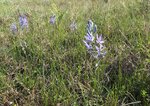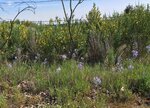


Camas is blooming in Thurston County prairies this week, including prairie land on JBLM. It’s also blooming in the median of I-5 in Hawks Prairie.
This small blue flower is a hardy native survivor. In spite of all the ploughing, grazing, building and paving that’s taken place on prairies during the past century and a half, camas flourishes in natural area preserves, along roadsides, and in unused pastures. Last Saturday, the Mima Mounds Natural Preserve was covered in waves of blue flowers. In this warm, sunny weather they’re fading fast, but there are plenty still in bloom.
Native communities used to burn local prairies to keep them from being overtaken by brush and trees. Now, oddly enough, some of the most productive prairie and camas habitat is on the artillery impact areas of JBLM that are burned periodically.
Camas bulbs were among the prairie plants Native communities dined on before settlers showed up – and it still is.
In the 1970 film “As Long As the River Runs,” Willie Frank, Sr., a Nisqually Indian born in 1879, describes the prairies, which he knew from Chehalis to the Puyallup Valley, and what they meant to his community.*
“The Nisqually Indians lived in paradise. . . Everything grew here, all kinds of plants: carrots, potatoes, onions, a whole lot of other plants Indians used to gather up. Roots, the white man calls them roots, I guess that’s what they were because they grew out of the ground. The Indians used to gather them up and bake them -- take it all down the river when it’s a big jam, lot of wood, and a whole lot of other plants and bake all this stuff all together. And one little plant was like a carrot, very short, little but it was black, and it was sweet, very sweet, and would sweeten all the other roots, like camas and the root of the sunflower. That made nice eating.”
“We didn’t have to – what do you call it? – fertilize. All those plants just come up by themselves, every year. They didn’t need fertilizer; they had Mother Nature.”
“Then a white man come with a lot of sheep – unloaded off a ship – the sheep went out and grazed, left nothing, no more. Then pretty soon Indians had to live like white man – buy flour, coffee, that kind of stuff.”
These days, many Indian communities are working toward “food sovereignty” and the return of the plants they used to eat. Camas harvesting is returning to some tribes, partly because of efforts to preserve the remaining prairie habitat, and all the plants, birds and butterflies that depend on it.
Our local blue camas grows in many parts of the state, but East of the Cascades and in the San Juan Islands, a bigger, purple camas is also common. (A few plants of purple camas are blooming now near the Lybarger Street entrance to Mission Creek Park in Olympia; someone must have planted them there.)
Beware the look alike
There is also a much less common white camas relative that is poisonous; its name is “death camas.” It often grows alongside blue camas. Only by harvesting camas while it’s blooming can you be sure you are not harvesting death camas by mistake. Beware.
Camas and death camas aren’t entirely look-alikes; the flowers of Camas are BLUE, death camas flowers are WHITE.
If you do intend to harvest and cook camas, do so only on private land with the owner’s permission, and leave plenty in the ground for the future. There are cooking instructions online for boiling, mashing steaming and drying them.
Camas bulbs are easy to grow, and available from many online nurseries. They grow in the thin, gravelly soil of local prairies, so they have proved themselves well-suited to poor soil and dry summer conditions. Planted in richer garden soil, they grow bigger and multiply abundantly. The purple and blue varieties would be particularly beautiful together.
It’s wonderful to have this garden connection to the history of our Native neighbors and our many thousands of years of glacial heritage.
Camas is also an enchanting starry blue flower that Mother Nature obviously likes a lot.
*Willie Frank was 91 at the time he was interviewed; he lived to be 103. He was the father of Billy Frank Jr. and the grandfather of Willie Frank III, who is now the Nisqually Tribal Council Chairman. His description of local plants and animals starts at the 32-minute mark of the hour-long film; he is introduced and also speaks at the beginning of the film.
Jill Severn writes from her home in Olympia, where she grows vegetables, flowers, and a small flock of chickens. She loves conversation among gardeners. Start one by emailing her at jill@theJOLTnews.com
Editors note: the following clarification was added: Camas and death camas aren’t entirely look-alikes; the flowers of Camas are BLUE, death camas flowers are WHITE.
2 comments on this item Please log in to comment by clicking here
bonaro
I feel it is remiss to not include more than 3 lines about Death Camas. This is a acutely toxic plant that is extremely similar to the edible variety and it can be found throughout the prairie.
Saturday, May 20, 2023 Report this
KellyOReilly
Thank you Jill for the information about Camas. I walk in Mission Creek Park regularly so I went out to find the purple Camas growing near the Lybarger St. entrance. They are lovely flowers and thanks to your article I now know what they are. I shared the article with a friend and she saw Camas growing at the Woodard Bay Conservation Area in Olympia. I also appreciate your inclusion of how Native Americans used these plants. I recommend Trova Heffernan's "Where The Salmon Run: The life and legacy of Billy Frank Jr" to readers interested in more history about the Nisqually People.
Monday, May 22, 2023 Report this